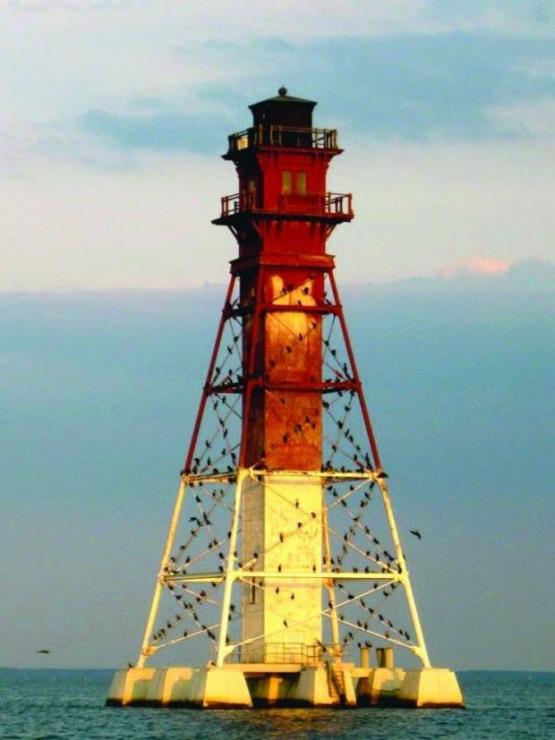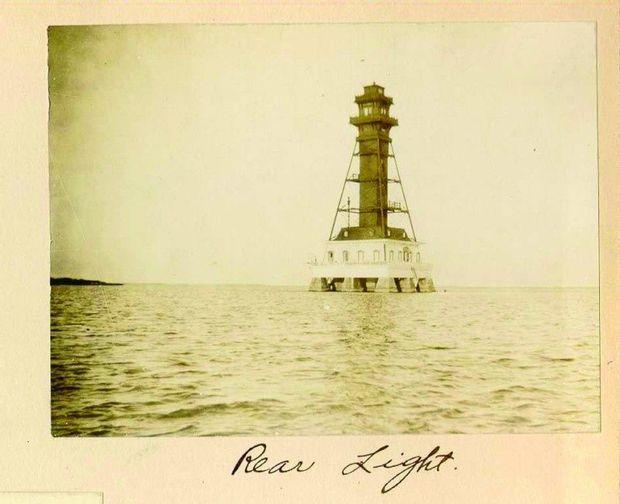
For those who don’t recognize the name, locals often think of this lighthouse as the Millers Island Light, though its full name is the Craighill Channel Lower Range Rear Light Station. It is located just off Pleasure Island and the Edgemere community of Baltimore County, and played a key role in the early port operations of Baltimore.
During the late 1800s, the Port of Baltimore was expanding rapidly, so in 1870, Craighill Channel was widened to 500 feet and deepened to 22 feet. The Lighthouse Board knew the importance of this channel, stating that it “has the advantage of saving about five miles in distance to large vessels bound to Baltimore from the lower Bay,” but without range lights the channel could not be navigated at night. On June 10, 1872, Congress appropriated $45,000 for two range lights to be built along the channel. Two more lights would later be constructed at the mouth of the Patapsco River.
Range lights are used in pairs to mark a channel. Each one of the pair supports a light of different heights, so when the two lights are aligned, you know you are in the channel. A small caisson structure was constructed for the front range and a granite pier foundation for the rear. The location of each structure had to be planned out precisely, for the rear light had to align with the front range light which was positioned about 2.4 miles to the south.
Construction began in 1873, but due to the expense of the foundations, the initial funds were exhausted before much work could be completed. On November 20, 1873, a temporary light was placed on the rear range light, but the keeper was forced to live in temporary accommodations onshore until additional funding could be obtained. Within a year, Congress provided additional funds ($65,000), and the rear light was completed in 1875.

The completed structure is a pyramidal iron frame surrounding a plate-encased stairway, leading to a double-decked lantern. It is 105 feet tall, making it the tallest lighthouse in Maryland and one of the tallest on the Chesapeake Bay. The interior of the tower is made of wood while the exterior is made of cast iron. The keeper’s house, a one-and-a-half-story structure, was located on the base of the foundation inside the framework. An enclosed stairway extends from the residence to the service room, watchroom, and the lantern room. A deck surrounds both the watchroom and the lantern room above. A fourth-order Fresnel range lens with a fixed white light was installed in the lantern room.
The structure was automated in 1923 and then connected to commercial electricity via a submarine cable in 1929. By 1938 the keeper’s dwelling was dismantled.
More than 70 years later, the historic Fresnel lens was removed by Coast Guard personnel and transported to a Coast Guard exhibit for safe storage. Today, all four lights in Craighill Channel are on the National Register of Historic Places, protecting them for future generations to enjoy.
 For those who don’t recognize the name, locals often think of this lighthouse as the Millers Island Light, though its full name is the Craighill Channel Lower Range Rear Light Station. It is located just off Pleasure Island and the Edgemere community of Baltimore County, and played a key role in the early port operations of Baltimore.
During the late 1800s, the Port of Baltimore was expanding rapidly, so in 1870, Craighill Channel was widened to 500 feet and deepened to 22 feet. The Lighthouse Board knew the importance of this channel, stating that it “has the advantage of saving about five miles in distance to large vessels bound to Baltimore from the lower Bay,” but without range lights the channel could not be navigated at night. On June 10, 1872, Congress appropriated $45,000 for two range lights to be built along the channel. Two more lights would later be constructed at the mouth of the Patapsco River.
Range lights are used in pairs to mark a channel. Each one of the pair supports a light of different heights, so when the two lights are aligned, you know you are in the channel. A small caisson structure was constructed for the front range and a granite pier foundation for the rear. The location of each structure had to be planned out precisely, for the rear light had to align with the front range light which was positioned about 2.4 miles to the south.
Construction began in 1873, but due to the expense of the foundations, the initial funds were exhausted before much work could be completed. On November 20, 1873, a temporary light was placed on the rear range light, but the keeper was forced to live in temporary accommodations onshore until additional funding could be obtained. Within a year, Congress provided additional funds ($65,000), and the rear light was completed in 1875.
For those who don’t recognize the name, locals often think of this lighthouse as the Millers Island Light, though its full name is the Craighill Channel Lower Range Rear Light Station. It is located just off Pleasure Island and the Edgemere community of Baltimore County, and played a key role in the early port operations of Baltimore.
During the late 1800s, the Port of Baltimore was expanding rapidly, so in 1870, Craighill Channel was widened to 500 feet and deepened to 22 feet. The Lighthouse Board knew the importance of this channel, stating that it “has the advantage of saving about five miles in distance to large vessels bound to Baltimore from the lower Bay,” but without range lights the channel could not be navigated at night. On June 10, 1872, Congress appropriated $45,000 for two range lights to be built along the channel. Two more lights would later be constructed at the mouth of the Patapsco River.
Range lights are used in pairs to mark a channel. Each one of the pair supports a light of different heights, so when the two lights are aligned, you know you are in the channel. A small caisson structure was constructed for the front range and a granite pier foundation for the rear. The location of each structure had to be planned out precisely, for the rear light had to align with the front range light which was positioned about 2.4 miles to the south.
Construction began in 1873, but due to the expense of the foundations, the initial funds were exhausted before much work could be completed. On November 20, 1873, a temporary light was placed on the rear range light, but the keeper was forced to live in temporary accommodations onshore until additional funding could be obtained. Within a year, Congress provided additional funds ($65,000), and the rear light was completed in 1875.
 The completed structure is a pyramidal iron frame surrounding a plate-encased stairway, leading to a double-decked lantern. It is 105 feet tall, making it the tallest lighthouse in Maryland and one of the tallest on the Chesapeake Bay. The interior of the tower is made of wood while the exterior is made of cast iron. The keeper’s house, a one-and-a-half-story structure, was located on the base of the foundation inside the framework. An enclosed stairway extends from the residence to the service room, watchroom, and the lantern room. A deck surrounds both the watchroom and the lantern room above. A fourth-order Fresnel range lens with a fixed white light was installed in the lantern room.
The structure was automated in 1923 and then connected to commercial electricity via a submarine cable in 1929. By 1938 the keeper’s dwelling was dismantled.
More than 70 years later, the historic Fresnel lens was removed by Coast Guard personnel and transported to a Coast Guard exhibit for safe storage. Today, all four lights in Craighill Channel are on the National Register of Historic Places, protecting them for future generations to enjoy.
The completed structure is a pyramidal iron frame surrounding a plate-encased stairway, leading to a double-decked lantern. It is 105 feet tall, making it the tallest lighthouse in Maryland and one of the tallest on the Chesapeake Bay. The interior of the tower is made of wood while the exterior is made of cast iron. The keeper’s house, a one-and-a-half-story structure, was located on the base of the foundation inside the framework. An enclosed stairway extends from the residence to the service room, watchroom, and the lantern room. A deck surrounds both the watchroom and the lantern room above. A fourth-order Fresnel range lens with a fixed white light was installed in the lantern room.
The structure was automated in 1923 and then connected to commercial electricity via a submarine cable in 1929. By 1938 the keeper’s dwelling was dismantled.
More than 70 years later, the historic Fresnel lens was removed by Coast Guard personnel and transported to a Coast Guard exhibit for safe storage. Today, all four lights in Craighill Channel are on the National Register of Historic Places, protecting them for future generations to enjoy.